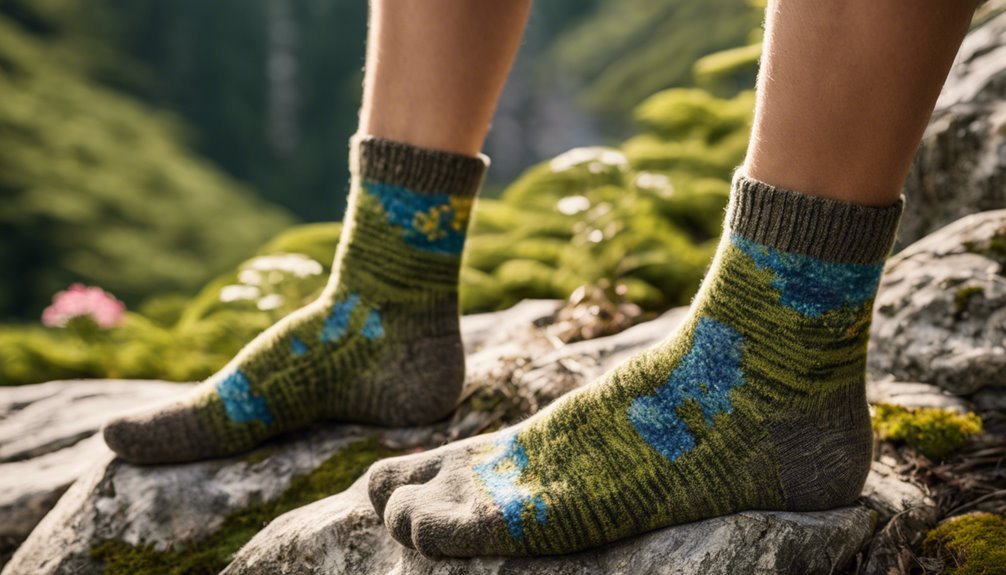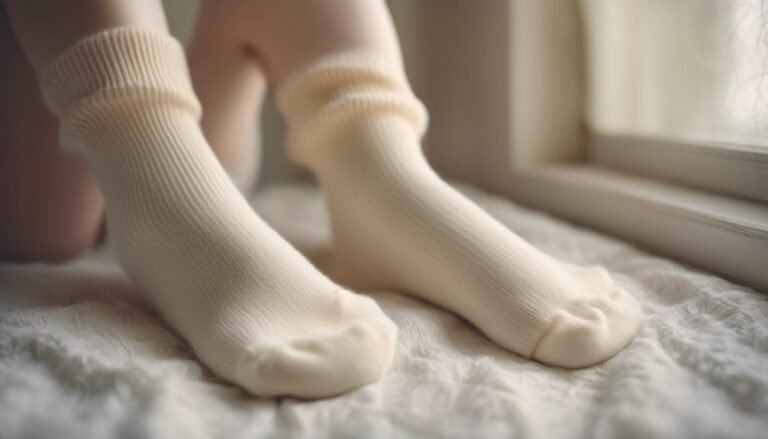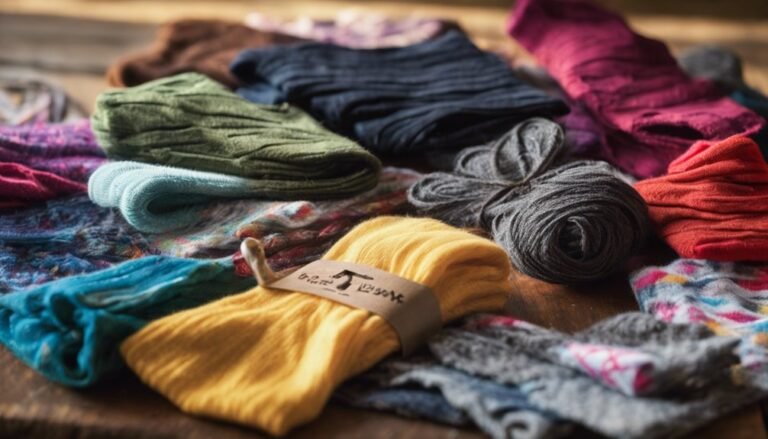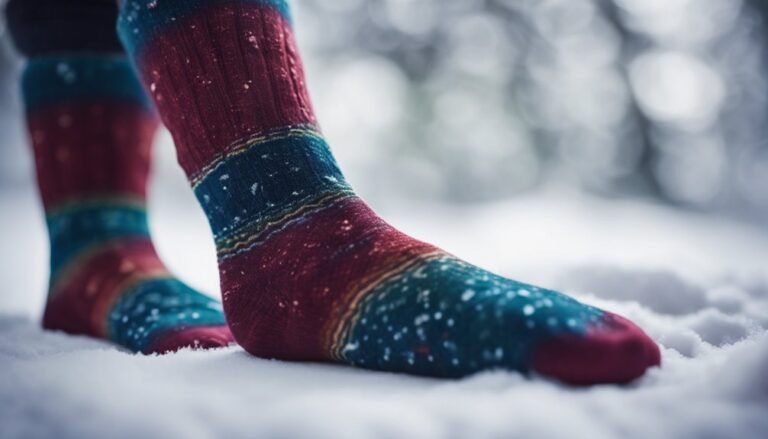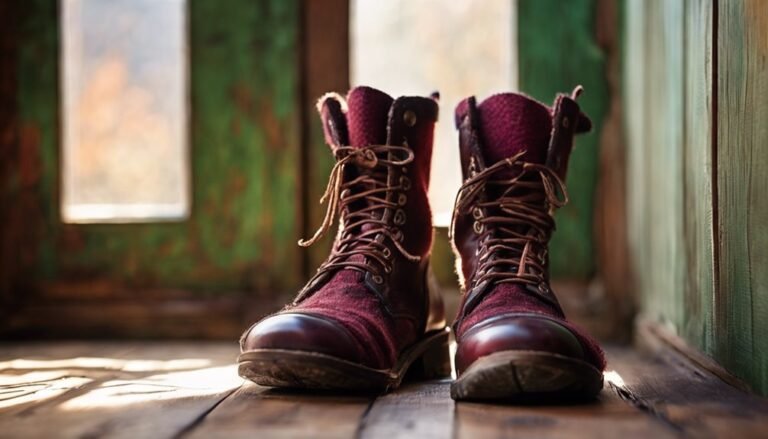Best Socks for Hiking and Trekking
Choosing the best socks for hiking and trekking is essential for comfort and protection. Look for moisture-wicking materials that keep your feet dry and reduce blister risk. Opt for cushioning and support to absorb impact on rugged terrain. Consider breathable options with ventilated panels for warm hikes, and insulated socks for cold weather. Quality brands like Smartwool and Darn Tough offer durability and performance. There's much more to discover about features that can elevate your hiking experience!
Importance of Choosing the Right Hiking Socks
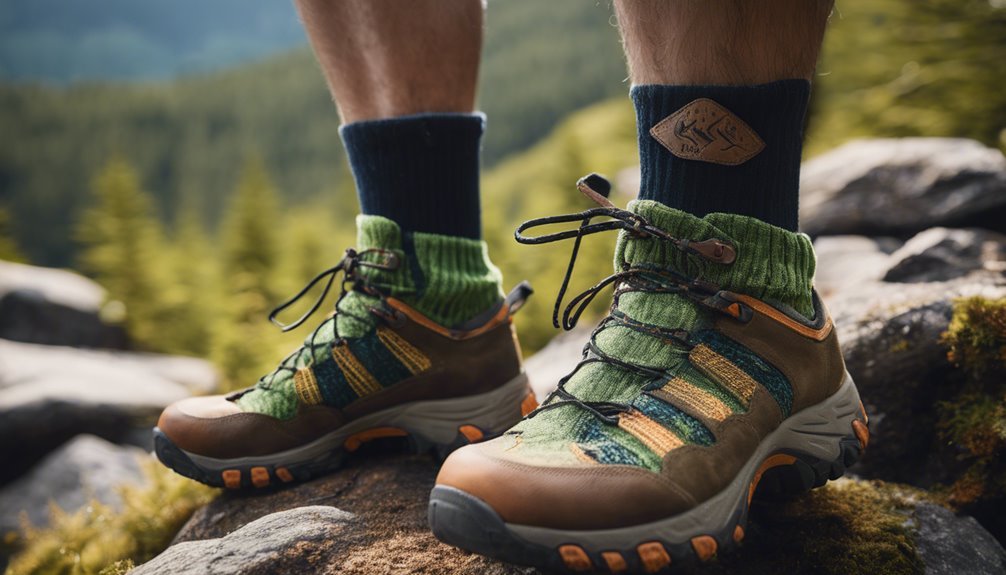
When you hit the trails, choosing the right hiking socks can make all the difference in your comfort and performance. Quality socks not only enhance your hiking experience but also contribute greatly to your foot health. Look for sock durability; a pair that can withstand the rigors of the trail will save you money and hassle in the long run. Durable socks resist wear and tear, reducing the risk of blisters and discomfort. The right material helps wick moisture away, keeping your feet dry and reducing the chance of fungal infections. Investing in the right hiking socks allows you to focus on the journey ahead, exploring the freedom of nature without worrying about your feet. Prioritize comfort and durability for an unbeatable outdoor adventure.
Key Features to Look For
Finding the right hiking socks means knowing what key features to look for to guarantee you get the best performance and comfort on the trail. Here are three essential aspects to take into account:
- Moisture-wicking properties: Keeps your feet dry and blister-free.
- Cushioning and support: Provides comfort and absorbs impact during long treks.
- Sustainable sock options: Think about eco-friendly materials for a greener choice.
With the latest sock technology innovations, you can find socks that not only perform well but also reduce your environmental footprint. Look for features like seamless construction and targeted compression zones for added comfort. Prioritize these characteristics, and you'll set off on your adventures with confidence, knowing your feet are well-equipped for the journey ahead.
Types of Materials Used in Hiking Socks
Selecting the right materials for your hiking socks can greatly impact your comfort and performance on the trail. The construction of your hiking socks is vital, especially when considering breathability, moisture-wicking, and durability. Here's a quick overview of common materials:
| Material | Benefits | Sustainability |
|---|---|---|
| Merino Wool | Excellent warmth & moisture-wicking | Naturally renewable |
| Nylon | High durability & stretch | Often recyclable |
| Bamboo | Soft, breathable & anti-odor | Fast-growing & eco-friendly |
Opting for sustainable sock materials not only helps the environment but can also enhance your hiking experience. So, choose wisely and enjoy the freedom the right socks provide on your adventures!
Cushioning and Support: Why It Matters
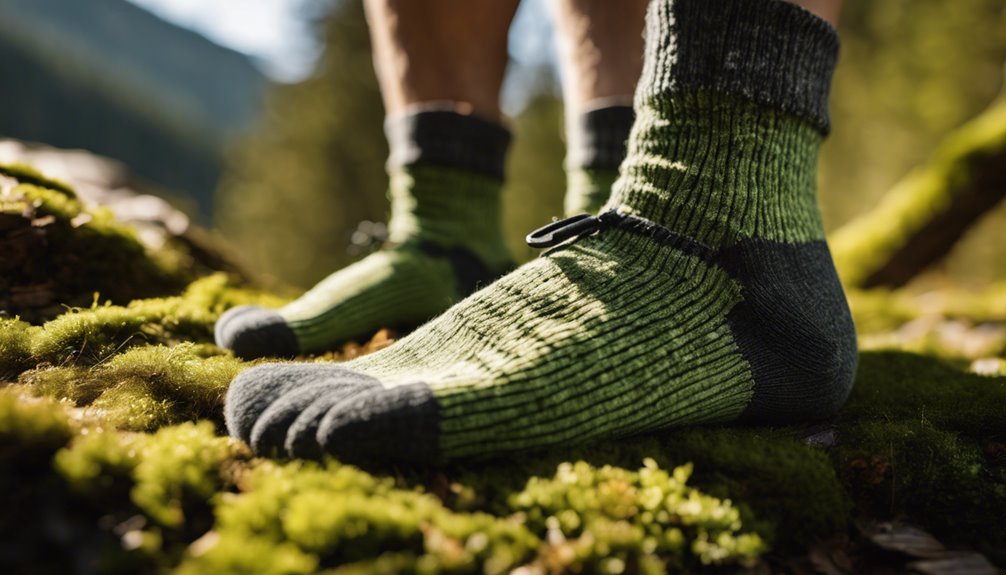
While the materials of your hiking socks lay the foundation for comfort, the cushioning and support they provide are what truly enhance your experience on the trail. The right cushion types and support levels can mean the difference between a blistered foot and a smooth trek.
Consider these factors when choosing your socks:
- Cushion Types: Look for options like full foot, heel, or toe cushioning.
- Support Levels: Determine if you need moderate or maximum support based on your hiking style.
- Fit and Flexibility: Make sure your socks offer a snug, yet flexible fit for peak performance.
With the right cushioning and support, you'll not only enjoy greater comfort but also the freedom to explore further and longer on your adventures.
Moisture-Wicking Properties
When you're hitting the trails, moisture-wicking properties in your socks are essential for keeping your feet dry and comfortable. Different materials, like merino wool and synthetic blends, offer varying levels of moisture management, so understanding these options can make all the difference. Plus, a proper sock fit enhances these benefits, allowing you to focus on the hike ahead without distractions.
Importance of Moisture-Wicking
Moisture-wicking properties are essential for hiking socks, as they help keep your feet dry and comfortable during long treks. When you're out exploring, the last thing you want is dampness leading to blisters. Effective moisture management techniques can make all the difference. Here's why you should prioritize moisture-wicking in your hiking sock styles:
- Enhanced Comfort: Keeps your feet feeling fresh, reducing fatigue.
- Blister Prevention: Minimizes friction caused by wet socks.
- Temperature Regulation: Helps maintain a stable foot temperature in varying conditions.
Choosing the right moisture-wicking socks guarantees you can focus on the adventure ahead, rather than discomfort. Embrace the freedom of the trails with socks designed to manage moisture effectively!
Material Types Explained
Choosing the right material for your hiking socks can greatly impact your comfort and performance on the trail. When it comes to moisture-wicking properties, synthetic fabrics like polyester and nylon excel, pulling sweat away from your skin while maintaining fabric breathability. Merino wool is another fantastic option; it's natural, offers excellent insulation, and manages moisture effectively.
Consider sock thickness as well—thicker socks provide cushioning but may trap heat, while thinner options enhance breathability. Look for a balance that suits your hiking conditions. Whether you're trekking through wet, humid climates or dry, arid landscapes, the right material will keep your feet dry, preventing blisters and ensuring you feel free to roam the trails without discomfort.
Proper Sock Fit
Finding the right fit for your hiking socks is just as important as selecting the right material, especially when it comes to moisture-wicking properties. A proper fit enhances comfort and keeps your feet dry, allowing you to embrace the great outdoors without distractions.
Consider these key factors for ideal sock fit:
- Sock thickness: Choose a thickness that matches your hiking boots for the best fit.
- Arch support: Make sure your socks provide adequate arch support to prevent fatigue on long treks.
- Moisture-wicking ability: Look for socks that effectively pull moisture away from your skin, keeping your feet dry and blister-free.
Length and Fit: Finding the Perfect Size
When it comes to hiking socks, the right length and fit are essential for comfort and performance. A properly sized sock prevents blisters and guarantees maximum moisture management, which can make or break your hiking experience. Let's explore how to find the perfect sock length and achieve an ideal fit for your next adventure.
Importance of Proper Length
Although it might seem minor, the length of your hiking socks plays an essential role in your overall comfort and performance on the trail. Choosing the right sock length can greatly enhance your experience, allowing you to focus on the adventure ahead.
Consider these factors when selecting sock length:
- Protection: Longer socks provide extra cushioning and prevent chafing against your boots.
- Heat Management: Different lengths can help regulate temperature, keeping your feet cool or warm as needed.
- Support: A proper length can offer additional arch and ankle support, enhancing your comfort levels.
When you're out there exploring, remember that the right sock length can make all the difference in how you enjoy your hike.
Achieving Ideal Sock Fit
Achieving the perfect sock fit is essential for a comfortable hiking experience, and it goes beyond just selecting the right length. You need to take into account sock sizing that complements your unique foot anatomy. A sock that's too tight can restrict circulation, while one that's too loose may cause friction and blisters. Pay attention to the heel and toe areas; they should fit snugly without excess material bunching up. Look for features like arch support and cushioning that enhance fit without compromising freedom of movement. Always try on socks with your hiking boots to verify compatibility. Remember, the right fit not only enhances comfort but also boosts your performance on the trail, allowing you to embrace the great outdoors fully.
Blister Prevention Techniques
Blisters can ruin a great hiking experience, but there are effective techniques to prevent them. Here are some blister prevention strategies you should consider:
- Sock Layering: Use a thin moisture-wicking liner sock under a thicker hiking sock to reduce friction.
- Proper Fit: Confirm your socks fit snugly but not too tight, preventing movement that causes blisters.
- Blister Care: Apply blister prevention products, like anti-chafe balms, to vulnerable areas before you hit the trail.
Recommended Brands for Hiking Socks
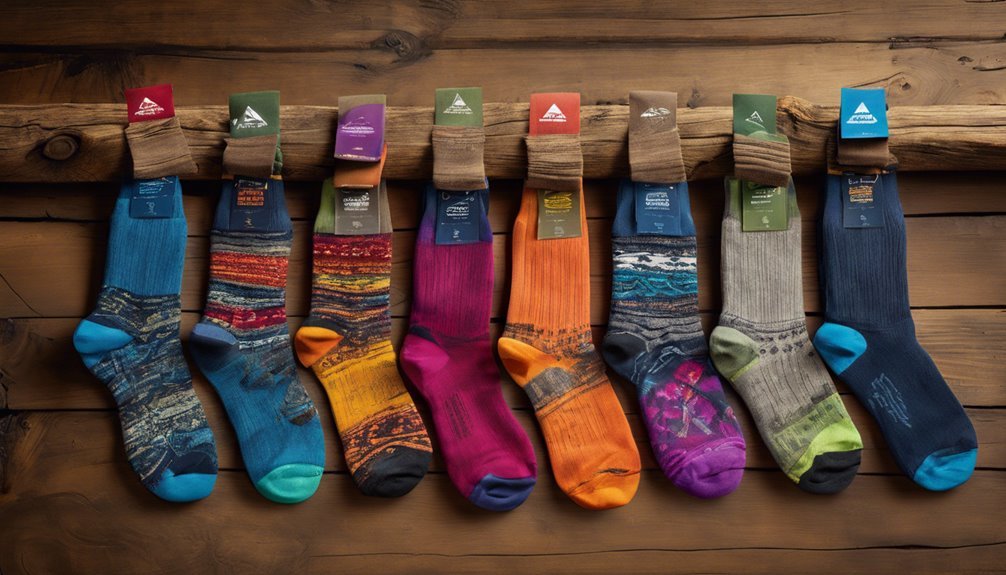
When it comes to finding the best hiking socks, there are several reputable brands that consistently deliver quality and performance. Brands like Smartwool and Darn Tough stand out for their sock durability, offering materials that wick moisture and provide cushioning. Merrell and REI also excel, balancing comfort and breathability, making them favorites among outdoor enthusiasts. In brand comparisons, consider the thickness and fit; thicker socks tend to offer more padding but may feel warmer. If you're after lightweight options, look into Wigwam or Fox River, which excel in ventilation. Ultimately, your choice should reflect your hiking style and the conditions you encounter, ensuring your feet stay comfortable and blister-free on every adventure.
Care and Maintenance of Hiking Socks
Although you might think that taking care of your hiking socks is a minor detail, proper maintenance can greatly extend their lifespan and improve performance. Here are some essential care tips to keep in mind:
- Washing Techniques: Always follow the manufacturer's instructions, usually cold water and gentle cycles. Avoid fabric softeners as they can break down fibers.
- Socks Storage: Store your socks in a cool, dry place, away from direct sunlight. This prevents moisture buildup and keeps them fresh.
- Drying: Air-dry your socks instead of tossing them in the dryer. High heat can damage elastic and wicking properties.
Tips for Selecting Socks for Different Weather Conditions
When you're choosing hiking socks, the weather can make a big difference in your comfort and performance. For warm conditions, opt for lightweight materials that wick moisture away, while in colder climates, you'll want socks that provide insulation and retain heat. Understanding these factors will help you select the right pair for your adventure.
Warm Weather Materials
Choosing the right materials for warm weather hiking socks can greatly enhance your comfort on the trail, as the right fabric helps regulate temperature and wick away moisture. When selecting socks for those hot days, focus on breathable fabrics and lightweight options that allow your feet to stay dry and cool.
- Look for merino wool blends, as they offer breathability without overheating.
- Consider synthetic materials like polyester for effective moisture-wicking properties.
- Choose socks with mesh panels for increased ventilation.
Cold Weather Insulation
To stay warm and dry during cold weather hikes, it's crucial to select socks that provide both insulation and moisture management. Look for materials like merino wool or synthetic blends, as they offer excellent thermal retention while wicking away sweat. Opt for socks with multiple insulation layers, which trap heat and prevent cold air from reaching your skin. A thicker sock can provide extra cushioning, but make sure it fits well to avoid blisters. Compression features can enhance circulation, keeping your feet warm longer. Additionally, consider socks with strategic padding that protects high-friction areas. By choosing the right cold weather socks, you'll guarantee your feet stay comfy and ready for adventure, no matter the conditions.
Frequently Asked Questions
How Often Should I Replace My Hiking Socks?
You might think you can keep your socks forever, but sock lifespan varies by materials. Replace them every 6-12 months to guarantee comfort and prevent blisters. Quality socks enhance your freedom on every adventure!
Can I Wear Cotton Socks for Hiking?
You might think cotton socks are fine, but they've got disadvantages. Their moisture retention issues can lead to blisters and discomfort. For outdoor adventures, it's best to opt for moisture-wicking materials instead.
What Are the Signs of Worn-Out Hiking Socks?
When your socks start feeling like that worn-out leather jacket from your youth, it's time to check for thinning material, loose fit, and holes. Proper sock material and fit are essential for comfort and performance.
Do Hiking Socks Come in Different Thicknesses?
Yes, hiking socks come in various thicknesses, each offering unique benefits. Thicker materials provide cushioning and warmth, while thinner options enhance breathability and moisture-wicking. Choosing the right thickness can greatly impact your comfort and performance.
How Should I Wash and Dry My Hiking Socks?
For sock care, you'll want to use gentle washing techniques. Wash 'em in cold water with mild detergent, and avoid fabric softeners. Air dry flat to preserve their performance and prevent pesky shrinkage.

